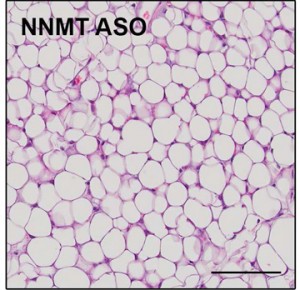By manipulating a biochemical process that underlies cells’ energy-burning abilities, investigators at Harvard Medical School and Beth Israel Deaconess Medical Center have made a novel discovery that could lead to a new therapy to combat obesity and diabetes.
Published in the April 10 issue of the journal Nature, the new findings show that reducing the amount of nicotinamide N-methyltransferase protein in fat and the liver dramatically reduces the development of obesity and diabetes in mice.
“With this discovery, we now have a means of metabolic manipulation that could help speed energy production and lead to weight loss,” said senior author Barbara Kahn, the George Richards Minot Professor of Medicine at HMS and vice chair of research strategy in the Department of Medicine at Beth Israel Deaconess. “Our findings are particularly exciting because the antisense oligonucleotide technology we used to inhibit the NNMT gene in our study is already being used to treat other diseases in humans.”
NNMT is an enzyme that processes vitamin B3 and has been linked to certain types of cancer, as well as to Alzheimer’s disease, explained co-corresponding author Qin Yang, assistant professor of medicine at HMS and a Klarman Scholar at Beth Israel Deaconess. “Now we have identified an entirely new role for this enzyme in fat tissue, and that is to regulate energy metabolism,” he added.
The new findings hinge on a biochemical mechanism known as a futile cycle, in which cellular reactions are sped up, thereby generating more energy. “We all know people who can seemingly eat whatever they want and not gain weight,” said Kahn. “Part of the reason for this natural weight control owes to basal cellular metabolism—the body’s inherent rate of burning energy. A futile cycle is one way to speed up energy utilization in cells.”
The investigators first confirmed that levels of NNMT were increased in obese and diabetic mice.
“In a comparison of genetic profiles of fat from mice that were either prone to or protected from developing diabetes, we discovered that the animals that were prone to develop diabetes had a lot of NNMT in the fat and liver,” said Yang. Together with co-first author Daniel Kraus of the University of Wurzburg in Germany, Kahn and Yang hypothesized that reducing NNMT levels in these tissues would accelerate a series of metabolic reactions involving molecules called polyamines, thereby leading to increased energy expenditure, increased leanness and reduced risk of diabetes and its complications.
“Polyamines are a group of biological molecules that are found throughout the body, which have fundamental functions, including regulating cell growth,” explained Kraus. “What’s interesting about the polyamines is that the process of building and degrading them creates a biochemical cycle in which energy is used up. This is a futile cycle.” The team discovered that NNMT inhibition speeds up this futile cycle, resulting in more dietary calories being burned for energy and fewer calories being incorporated into fat.
Kahn noted that the team used antisense oligonucleotide technology to knock down the NNMT gene. ASOs are short molecular strings of DNA that can be designed to prevent the synthesis of specific proteins.
“When an ASO is transferred into a cell, it can target a specific gene and suppress it, as was the case with NNMT,” said Kahn. “Because ASOs have already been approved by the U.S. FDA for the treatment of genetic causes of elevated cholesterol or hyperlipidemia, as well as for the treatment of a viral eye infection, it’s possible that clinical trials to test an ASO anti-obesity therapy in humans could readily move forward.”
More than one-third of the U.S. adult population is currently obese, according to the U.S. Centers for Disease Control and Prevention. “Obesity is a serious economic burden to our healthcare system and a major risk factor for developing insulin resistance and diabetes,” said Kahn. “While diet and exercise are important in controlling weight, anti-obesity therapies could be of tremendous help, and NNMT looks to be a promising target for future therapeutic development. Furthermore, because obesity is associated with an increased incidence of Alzheimer’s disease and certain cancers in which NNMT is also elevated, an NNMT ASO could potentially also be beneficial in managing these other devastating conditions.”
Originally published by Harvard University – adapted from a Beth Israel Deaconess news release.









